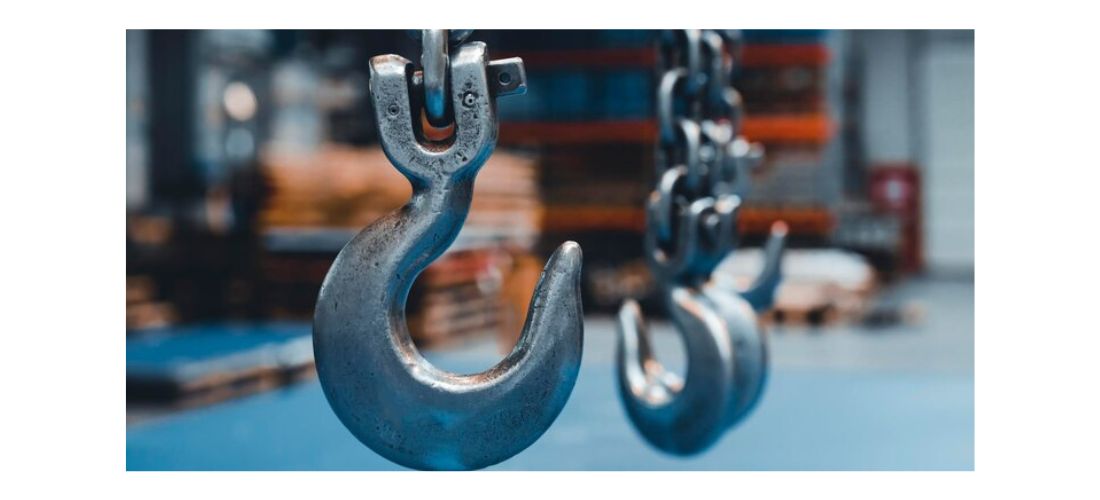Blog
Choose the Right Lifting Hooks: A Complete Guide
In industries like construction, manufacturing, and logistics, lifting hooks help with material handling, lifting, and rigging operations. Selecting the appropriate lifting hook is critical in terms of security, productivity, and duration.
This blog will cover the various types of lifting hooks, important considerations when choosing one, how to choose the right lifting hooks, and how to use them safely and effectively.
Understanding Lifting Hooks and Their Importance
A lifting hook is used to attach slings to move and lift loads. Commonly used in cranes, hoists, and other lifting gear. Selecting appropriate hooks is of utmost importance for safe lifting operations, minimizing the chances of accidents and boosting efficiency in heavy-load applications.
Why Choosing the Right Hook Matters:
- Minimizes load slippage and accidents
- Make sure it is in accordance with the safety standards
- Increased productivity during lifting operations
- Minimizes wear on lifting devices
Types of Lifting Hooks
There are a variety of lifting hooks available, each suitable for a particular application. Knowing their characteristics and use cases will help you make the right decision.
1. Eye Hooks
Provide a strong, round eye for attaching to chains, slings, or ropes.
Specialize in creating safe connections and Heavy lifting.
Require proper shackles/links to be used for connection.
Best For: General rigging and lifting applications.
2. Clevis Hooks
Have a U clevis and a pin for attaching.
Make it easy to plug in and unplug.
They offer greater flexibility compared to eye hooks.
Best For: Fast setup and takedown.
3. Slip Hooks
Have a larger throat opening for swift attachment.
They can often be used in conjunction with a safety latch to help prevent disengagement of the load.
Best For: Cycles with frequent upward and downward movement.
4. Grab Hooks
These hooks are commonly found at the ends of chain or ratchet load binders for load securement and hauling.
Shaped with a narrow throat to hold the chain firm.
Stops chain from slipping too far; no safety latch included.
Best For: Reducing chain lengths in rigging applications.
5. Swivel Hooks
These hooks operate similarly to hoist hooks yet feature an integrated swivel at the top of the hook that allows you to position the hook in whichever orientation desired prior to the lift.
Able to spin freely to avoid tangling of slings and lifting chains.
Some models will also utilize a bearing so that they will rotate under load.
Best For: When you need to rotate between loads.
6. Locking Hooks
Close and lock automatically under load.
Choose the right lifting hooks that increase safety by avoiding accidental unhooking.
Best For: Heavy-duty lifting where safety is key.
Factors to Consider When Choosing the Right Lifting Hook
Choosing the right type of lifting hook is pivotal, as different hooks are designed for specific applications, load capacities, and safety conditions.
a) Load Capacity (Working Load Limit—WLL)
- The WLL is a guideline stating the maximum weight a hook is allowed to lift without causing structural failure.
- Always select a hook with a WLL greater than or equal to the anticipated load.
- The load should never exceed the WLL (working load limit). Friends, hook failure, and serious accidents can occur.
b) Material and Strength
Hooks made of alloy steel: high strength and durability.
Stainless Steel Hooks: Provide corrosion resistance for marine and chemical industries.
Hooks made of carbon steel: Useful for light-duty lifting applications.
c) Hook Size and Throat Opening
- The throat opening affects how quickly you can fit a hook to a load.
- The wider throat opening means that they can easily be attached but sometimes require additional velocities.
d) Safety Latch
- Includes a safety latch to help keep the load from coming loose.
- Crucial for hoisting hooks for overhead lifting applications.
e) Hook Rotation and Swivel Functionality
- Swivel hooks prevent load twisting and improve load stability.
- In cases where rotation isn't necessary, fixed hooks are superior.
f) Environmental Considerations
- Stainless steel or coated hooks are a must in high-humidity or corrosive environments.
- Special heat-treated hooks may be required when applications encounter extreme temperatures.
g) Certification and Compliance
- Look for ASME B30.10 or EN 1677 certified for safety standards compliance.
- Hooks need to be load tested and inspected periodically.
Inspection & Maintenance of Lifting Hooks
Regular maintenance and inspection keep lifting hooks safe to use.
Daily Inspection Checklist
- Look for any deformation or cracks that are visible.
- Check for corrosion or excessive wear.
- Check that the safety latch operates properly.
Periodic Load Testing
- Implement NDT to check for internal defects.
- Conduct load testing annually or as per safety regulations.
Replacing Worn Hooks
- Replace the hook immediately if it is found to have excessive wear (over 10% of original thickness).
- Never fix a cracked or deformed hook—always replace it.
Choosing the Right Supplier for Lifting Hooks
Few things to remember while choose the right lifting hooks:
Reputation and Reliability: Select automotive components manufacturers with a track record of quality and adherence to safety regulations.
Certifications: Make sure hooks are tested and meet ASME/EN design specifications.
Customization Options: Certain suppliers provide custom hooks for particular uses.
Availability of Warranty and Support: Choose suppliers who can give warranty and support.
Conclusion
It is important to choose the Right Lifting Hooks as a part of lifting systems to ensure safe and efficient lifting operations. Kalaria Auto Forge Pvt. Ltd will help you to know about the different hook types, selection criteria, and safety tips will help to ensure the best possible performance and workplace safety. Inspect and perform regular care on lifting hooks, and follow industry standards to avoid accident.
Read more: Difference Between Open Die Forging and Closed Die Forging

